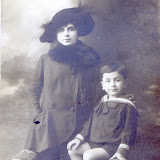A La Franga in Turkey and Bulgaria
" What, do you mean a little fellow, with double whiskers, and blue spectacles?"
" Yes, sir, the photographer."
" Oh, he's a good little Ghiaour enough. He always takes off his hat to me, a la franga, in the street. I thought he was a Frenchman."
Ivan Vazov; Under the Yoke, a romance of Bulgarian liberty, 1888
At first glance these photos might look like typical studio portraits from the turn of the last century, no different to what you would find in any western country at the time. In Constantinople and Sofia, where they were taken, they could be construed as political statements; not radical or explosive by any standards, more subtle perhaps than flaunting a ‘vote Teddy Roosevelt’ button though they were just as unambiguous.
In the 1880s women in Bulgarian and Turkish cities began wearing a la Franga fashions – broad brimmed hats, furs and gowns especially – as a way of identifying themselves as having French, which is to say Western, attitudes. It was more than a conscious rejection of Ottoman values; in a way it disparaged them, implying they were backward and unsophisticated. In Constantinople a la Franga belonged to the Armenians, the Levantines and Greeks, in Sofia, Plovdiv and Veliko Tarnovo it was the style of upper middle class Bulgarians. It was politics without a manifesto or even an ideology, more like a common act of self-expression. One thing everyone had in common was that they anticipated the imminent collapse of Ottoman rule.
The relationship between the Armenians and the French goes back centuries, to the first crusade to be precise, when Christian towns and forts offered sanctuary to crusader armies. For some French intellectuals Armenia came to represent a hopeful bastion of Christianity in a region surrounded by Muslims and other infidels. By the late 19th century French had become the language of business in Constantinople, which explains why so many Armenian photographic studios adopted French names (Phebus, Abdullah Frères) and French Christian names were popular among Armenians (Pascal Sebah). Any studio in Constantinople with a French name was almost certainly Armenian (one exception being Photo Francais, run by the Jewish Romanian émigré, Jean Weinberg) and no tourist or non-Muslim resident of Pera ever called its main street by the official Ottoman name, Cadde Kebir. It was always La Grand Rue de Pera. Armenians living in Constantinople regarded France as the pinnacle of culture, and they weren’t alone in thinking that. When Abdülmecid I wanted a new residence to replace the Topkapi in 1843 he had the Dolmabahçe Palace built. To realize a home befitting a Sultan the architects looked to the baroque extravagance of Versailles for inspiration. Even the Ancien Regime was trés chic.
In Bulgaria a la Franga had different connotations. Rural Bulgarians were every bit as nationalistic and independence minded as the urban intellectuals but if pretensions to Frenchness weren’t exactly a betrayal they did seem to be replacing one set of foreign values with another. The A La Frangistes became objects of ridicule and satire, seen as too precious for their own good. In Ivan Vazov’s novel quoted above, a la Franga isn’t really to be trusted. Assuming a man is French implies he isn’t a true Bulgarian. Not that the haut bourgeoisie of Sofia and Plovdiv were too bothered by what rustic bohemians thought of them. A la Franga wasn’t just about wide hats and long gowns. It was a lifestyle encompassing household furniture, interior design, table manners, even toilets because in a country long used to the squat hole, an actual seat was a sign of wealth and elegance.
In Constantinople during the First World War ‘a la Franga’ was a snide remark aimed at anything suspiciously European. German military officials turned up with ‘a la Franga attitudes’ the Turkish soldiers wouldn’t buy into. Across the border Bulgaria was in a mess. Having declared its neutrality the Government found itself obliged to form an alliance with the empire it had just spent most of a century trying to be free from. After the Treaty of Neuilly-sur-Seine in 1919 when Bulgaria was forced to hand over its Aegean coast to Greece and other territory to Serbia, a la Franga didn’t sound so good there either. Still an image of French culture as sophisticated and worth aspiring to persisted. What killed it off wasn’t so much anti-French feeling as the shift in cultural attention that regarded America as the repository of all things desirable. Mind you, in the 1920s the place to see the hottest acts from across the Atlantic was Paris.
A la Franga belonged to that period around the turn of the century when people were conscious that the new century would be different, more technological, more modern, but they weren’t sure how that would be manifested. Looking around, France was the obvious model for culture even if by then its place as a centre for science and technology was over. As a fashion statement it managed to be contemporary and anachronistic at the same time.
 |
| A LA FRANGA |






These photos are beautiful and mysterious on their own, but with your explanation and background information, they are truly fascinating.
ReplyDelete